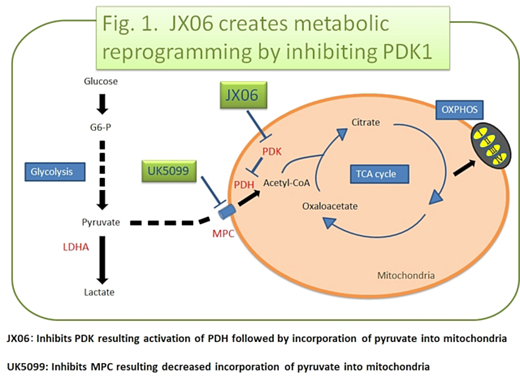Background: Despite the efficacy of novel agents, multiple myeloma (MM) is still an incurable disease. In order to achieve a cure, it is necessary to develop new therapeutic drugs, which target different pathways from the present anti-MM agents. PDK1 (pyruvate dehydrogenase kinase 1) is a glucose metabolism-related protein often induced by HIF-1. PDK1 inactivates PDH (pyruvate dehydrogenase) through phosphorylation, leading to enhanced glycolysis in the cytoplasm and suppression of oxidative phosphorylation in the mitochondria. PDK1 that is highly expressed in plasma cells is a downstream target of IRF4. We previously reported that PDK1 inhibition is a potent therapeutic strategy in MM (Fujiwara S et al. Br. J. Cancer; 108 (1): 170-178. 2013). However, PDK1 inhibitors, which are effective at low concentrations, are limited at present, making PDK1 inhibition difficult to apply in the clinic. In the present study, we examined the efficacy and mechanism of action of JX06, a novel PDK1 inhibitor, against MM cells.
Materials and methods: MM cell lines (NCI-H929,KMS-12PE,KMS-12BM,U266, KMM1, RPMI-8226) were treated with PDK1 inhibitor, JX06, in vitro. Caspase inhibitor, Z-VAD-FMK, was used in combination with JX06 to study the mechanism of JX06 induced MM cell death. Mitochondrial pyruvate carrier (MPC) inhibitor, UK5099, was utilized to block pyruvate transportation into the mitochondria. Bortezomib was used in combination with or without JX06. Growth inhibition of MM cell lines by JX06 were examined by WST-8 assay. Cytotoxicity of primary MM cells by JX06 was examined using flow cytometry after staining with 7AAD. Caspase 3 activity and PDH phosphorylation of MM cell lines were determined by Western blot. Cell cycle analysis of MM cell lines treated with or without JX06 was performed by flow cytometry using BrdU. Detection of apoptosis in MM cell lines were examined by Annexin V and PI staining followed by flow cytometry analysis.
Results: JX06 suppressed cell growth of various MM cell lines and primary myeloma cells at low concentrations (0.5-1.0 µM). MM cell death by JX06 accompanied caspase 3 activation and this cell death was suppressed under addition of Z-VAD-FMK, indicating that JX06 induced apoptosis in MM cells. Moreover, phosphorylation of PDH, known as a target of PDK1, was significantly suppressed under JX06 treatment, demonstrating that indeed JX06 exerts anti-MM effect by inhibiting PDK1-PDH pathway. Addition of UK5099 to JX06 suppressed JX06-induced MM cell death, demonstrating that the efficacy of JX06 depends on pyruvate transported into the mitochondria through MPC. There was no significant difference in cell cycle distribution between JX06 treated MM cells compared to control, suggesting that JX06 exerts cytotoxicity independent of cell cycle phase. Moreover, significant increase of cell death was observed in NCI-H929 cell line treated in combination with 0.25 µM JX06 and 2.5 nM bortezomib, although bortezomib alone at concentration of 2.5 nM didn't induce cell death.
Conclusion: We demonstrated that JX06 could induce apoptosis of MM cell lines and primary MM cells by inhibiting PDK1. JX06-induced MM cell death is mediated by metabolic shift from glycolysis in the cytoplasm to oxidative phosphorylation in the mitochondria (Fig. 1). Considering its efficacy and the distinct mechanism of action from the current anti-MM agents, JX06 can be a promising anti-MM agent. Furthermore, JX06 not only works as single agent, but can also enhance the efficacy of current anti-MM drugs, suggesting this combination lead to better treatment response and less toxicity.
Matsuoka:Kyowa Kirin Co., Ltd.: Research Funding; Bristol-Myers Squibb Corp.: Research Funding; Chugai Pharmaceutical Co., Ltd.: Honoraria.
Author notes
Asterisk with author names denotes non-ASH members.


This feature is available to Subscribers Only
Sign In or Create an Account Close Modal